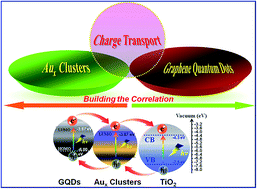Insight into the charge transport correlation in Aux clusters and graphene quantum dots deposited on TiO2 nanotubes for photoelectrochemical oxygen evolution†
Abstract
In recent years, metal clusters-based photoelectrocatalysis has elicited considerable attention; nonetheless, the exploitations of high efficiency metal clusters–semiconductor heterostructured photoelectrodes are still in the infant stage. Herein, by judiciously capitalizing on glutathione-capped gold (Aux) nanoclusters and graphene quantum dots (GQDs) as building blocks and spatially hierarchically ordered nanoporous TiO2 nanotube arrays (NP-TNTAs) as a conceptual semiconductor platform, GQDs and Aux clusters were rationally and closely integrated on the framework of NP-TNTAs through a progressive electrostatic self-assembly strategy. It was unraveled that Aux clusters play a decisive role in triggering the cascade interfacial charge transfer from GQDs to NP-TNTAs owing to their cooperative synergy, thereby affording conspicuously enhanced solar-powered photoelectrochemical (PEC) water splitting performances under simulated solar light irradiation. Furthermore, the specific PEC water splitting mechanism was unambiguously determined, which for the first time bridges the gap between metal clusters and carbon materials in terms of intrinsic correlations in the charge transfer pathway. It is anticipated that our work would spur further interest in exploring metal cluster-based PEC systems for solar energy conversion.



 Please wait while we load your content...
Please wait while we load your content...